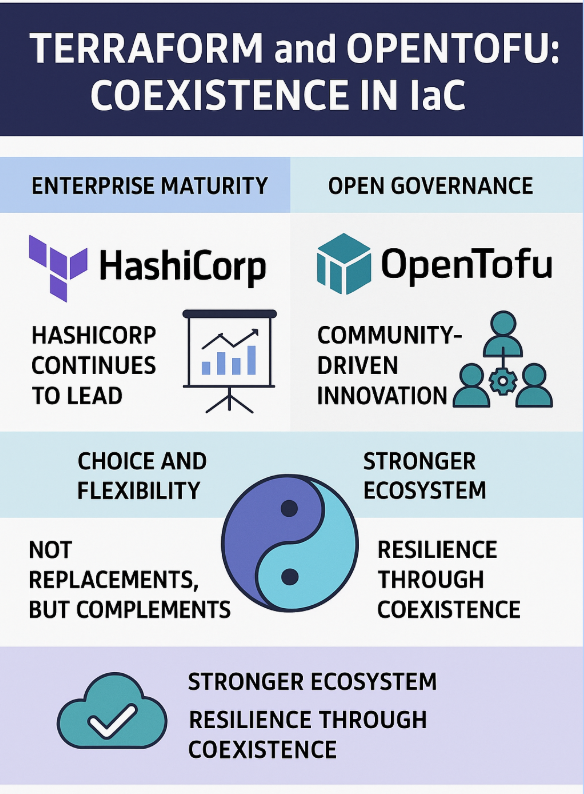OpenTofu and the New Era of Infrastructure as Code
Infrastructure as Code (IaC) has become the backbone of modern digital infrastructure. For nearly a decade, Terraform has been the go-to language for provisioning, scaling, and managing resources across the cloud. It didn’t just set the standard — it became the standard.
But the story of IaC took a new turn in 2023 when HashiCorp announced its decision to change Terraform’s license from the MPL to the Business Source License (BUSL). That change sparked debate and ultimately led to the birth of OpenTofu, a community-driven fork housed under the Linux Foundation and the CNCF.
Some saw this as a showdown. In reality, what has emerged is a more nuanced truth: A marketplace where both Terraform and OpenTofu coexist, each serving different needs and constituencies, and the ecosystem may actually be healthier for it.
How We Got Here
Terraform’s dominance didn’t happen by accident. HashiCorp invested years of engineering effort, built a robust provider ecosystem, and created a tool that became foundational to the cloud-native movement. Enterprises bet big on it because it worked.
When HashiCorp changed Terraform’s license, it was a business decision. The company wanted to protect its commercial interests in a world where cloud vendors could repackage and resell without contributing back. That’s not villainy — it’s the reality of balancing open source ideals with shareholder obligations.
But the move also energized the community. Many felt IaC was too important to be constrained by a single vendor. Out of that came OpenTofu: A fork designed to preserve an open governance model and guarantee long-term freedom for users.
The OpenTofu Difference
OpenTofu began by mirroring Terraform closely, offering a drop-in replacement for enterprises unwilling to risk disruption. But under CNCF stewardship, it has developed its own roadmap: More open governance, a transparent steering committee and an ethos of interoperability.
This is where OpenTofu shines — it represents the community’s desire to have a truly open and vendor-neutral option. Its future is not just about maintaining parity with Terraform, but about exploring innovations that emerge when the ecosystem collectively steers the ship.
Why Enterprises Should Care
For organizations running cloud-native infrastructure, this isn’t an either/or decision — it’s about choice.
- Terraform remains a proven, mature, enterprise-grade tool. Backed by HashiCorp, it continues to evolve with strong engineering, commercial support, and a massive ecosystem of providers and integrations.
- OpenTofu offers a community-governed alternative. For those worried about vendor lock-in, or who want a more open governance model, OpenTofu provides a hedge and a voice in shaping the roadmap.
The net result? Enterprises have more control over their IaC strategy than ever before.
Challenges and Opportunities
OpenTofu will need to prove it can balance innovation with stability, avoiding unnecessary fragmentation. Terraform, meanwhile, must show that it can coexist in a world where a viable fork exists.
Interestingly, HashiCorp seems to understand this. The company has acknowledged OpenTofu’s permanence and has shifted toward a more pragmatic stance: Competing where necessary, coexisting where possible. This isn’t the zero-sum game some feared. Instead, it’s an ecosystem where both projects push each other forward.
Shimmy’s Take: Two Paths, One Future
Infrastructure as Code is too critical to leave stagnant. In many ways, the existence of OpenTofu alongside Terraform is a sign of maturity, not fracture. We’ve seen this before in open source: Multiple implementations of core ideas driving innovation while serving different audiences.
HashiCorp deserves credit for pioneering the IaC model, building the provider ecosystem and continuing to invest in Terraform as a flagship tool. OpenTofu deserves recognition for ensuring the community has a voice and for protecting IaC as a commons. Together, they represent two sides of the same coin — commercial strength and community resilience.
What Leaders Should Do
If you’re a technology leader, here’s how to approach this dual ecosystem:
- Evaluate both. Don’t treat this as a binary choice. Many enterprises will use Terraform in some environments and OpenTofu in others.
- Future-proof strategy. Keep your workflows flexible enough to adapt to either path.
- Engage responsibly. Contribute where it makes sense—whether that’s through commercial support for Terraform or community contributions to OpenTofu.
Conclusion
OpenTofu isn’t a rebellion, and Terraform isn’t obsolete. What we have now is an ecosystem with more diversity, more choice and more innovation potential.
HashiCorp built Terraform into the defining IaC tool of a generation. OpenTofu ensures the community has a truly open alternative. Together, they form the new reality of IaC — one where coexistence, competition and collaboration all play a role.
And that, in the long run, is good for everyone.



